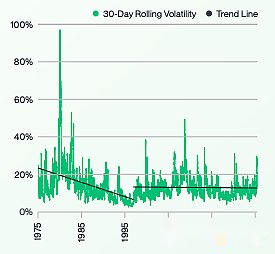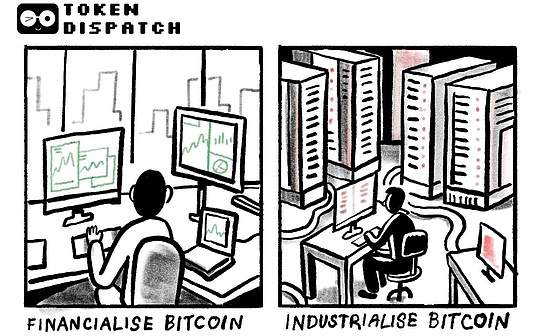
Source: Bitwise; Compilation: AIMan@Bitchain Vision
according to:Bitwise will release its first long-term capital market assumption for Bitcoin last week(Note: Long-term This market assumption refers to a prediction of the risks and returns of major global assets over the next 10 to 15 years, which plays a key role in building portfolios for professional investors).This is a data-driven report, released at the urging of some large U.S. financial institutions.The report lists Bitwise’s forecasts on the correlation between BTC returns, BTC prices, volatility and other assets over the next decade.This week, Bitwise released the full text of the research report, as follows:
summary
-
We expect the next 10 years to be a decade of strong development of Bitcoin, driven by the combined effect of three factors: (1) Bitcoin continues to rise as an institutional asset, which should generate sustained net inflows over time; (2) institutional investors’ demand for hard asset exposure as a hedge against inflation risks; and (3) Bitcoin’s new supply is extremely limited and inelastic.
-
We predict Bitcoin will be the best performing institutional asset in the next decade, with its price rising to $1.3 million by 2035 (a CAGR of 28.3% for the 10-year outlook).These returns will be accompanied by significant volatility, although this volatility will be below the historical average.
-
We believe Bitcoin will continue to show low correlations with stocks, bonds and all other major asset classes.
-
We believe that the “four-year cycle” in Bitcoin’s history is no longer applicable, but we warn that Bitcoin may still have a significant retracement.
-
The biggest risks we predict come from regulatory and legislative risks posed by changes in the political environment, as well as the risks inherent in Bitcoin as a relatively new and limited historical asset.Other risks, including technological disruptions related to quantum computing, are worth mentioning, although the attention is low.
-
The model for predicting Bitcoin’s future returns is not perfect, relatively new, still evolving, and relies on limited data.Therefore, we strive to be conservative.We think this is suitable for a new, highly volatile asset.
-
General trend:Over the past 16 years, Bitcoin has grown from an unproven concept to a $2.4 trillion asset and is increasingly owned by some of the world’s most respected investors.This is the hardest step in its growth process—to borrow Peter Thiel, the famous “moment from 0 to 1”.We believe that the next decade will witness Bitcoin “from 1 to 100”.
1. Macroeconomic assumptions
Bitcoin is first and foremost a macroeconomic asset.Therefore, macroeconomic conditions are crucial to our long-term capital market assumptions.
Specifically, Bitcoin is often seen as a means of digital store of value, or “digital gold.”While it has many other uses – and we expect some payment-related uses to gain attention over the next decade – its role as “digital gold” is at the heart of its investment argument.
In this regard, the most important macroeconomic factors to be considered are factors related to debt, deficits and fiat currency depreciation, and the US dollar’s role as the world’s dominant reserve currency, as these factors play a role in the institutional demand for gold-like assets.
We think these macroeconomic trends are easy to predict.Specifically, we expect major countries, including the United States, to continue to accumulate debt at an accelerated pace, and the increasing debt burden will put increasing pressure on these economies.As economist Lyn Alden said, “Nothing can stop this train.”
Over the next 10 years, we expect the government to deal with the increasing debt burden by devaluing its currency.As legendary hedge fund investor Ray Dalio wrote in June 2025:
“When state debt is too high, lowering interest rates and depreciating debt-denominated currencies are the preferred paths most likely to take by government policymakers, so it is worth betting on this that happens.”
1.1 U.S. debt is rising rapidly
The United States is about to celebrate its 250th anniversary, which is a milestone worth reflecting on.Here are five amazing facts about U.S. debt 250 years later:
01 / In its first 200 years, the United States has accumulated $650 billion in debt.Today, this number is $36.2 trillion.
02 / Half of all U.S. debt has been accumulated over the past 10 years.
03 / U.S. debt now exceeds $100,000 per capita.
04 / U.S. debt accounts for 120% of GDP.
05 / The annual interest payment for U.S. debt is $952 billion, making it the fourth largest expenditure item in the U.S. budget.
Total federal debt (trillion dollars)
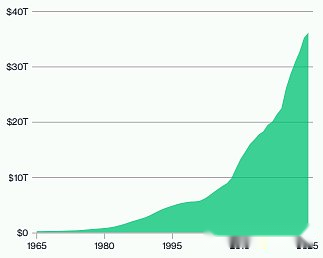
Source: Bitwise Asset Management, data from the U.S. Treasury Department, dated from January 1, 1966 to March 31, 2025.
1.2 DOGE: Thunder loudly, raindrops are small
Current government spending is worsening the situation.The Congressional Budget Office expects the U.S. deficit to increase by $1.9 trillion this year.
This is shocking for many, as the current U.S. government is elected under a mandate that promises to reduce government spending.In early 2025, President Trump appointed Elon Musk to lead a new entity called the Department of Government Efficiency (DOGE), which pledged to cut $2 trillion in government spending.Meanwhile, in Congress, deficit hawks talk about reducing the U.S. annual deficit from current levels (more than 6% of GDP) to 3% or less.
None of this happened.Less than six months later, Musk left the government, with DOGE’s cuts being minimal, while U.S. government spending hit an all-time high.
If one of the world’s leading entrepreneurs—and a broken tradition-breaking president who is not afraid to shake the system—cannot even slow down spending slightly, we doubt there is anything else.
Total cumulative spending since Trump took office compared with the same period in 2023 and 2024 ($ trillion)
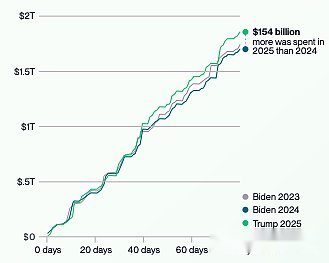
Source: Wall Street Journal and the Ministry of Finance.Data is as of April 11, 2025.
Note: The first day of 2025 is January 20; the dates for 2023 and 2024 are aligned with the day of the week in 2025, and leap years are considered.
1.3 Growing insurance demand
We do not think the United States is approaching hyperinflation or other doomsday scenarios.Instead, we are consistent with concerns expressed by many leaders — including agencies such as JPMorgan and BlackRock, as well as several former U.S. budget directors and chief economists — that the rising debt and deficit path is worrying and will erode the purchasing power of the dollar over time.
In turn, these trends may increase demand for illegal currency hedging tools such as gold and Bitcoin.The recent performance of these hedging instruments—both outperformed all other major assets since 2020—suggests investors are ready for this ever-changing world.
We don’t need to see catastrophic hyperinflation, and the value of inflation hedging instruments will rise significantly.This view is reflected in our price forecasts.
Performance of Bitcoin and major asset classes since 2020
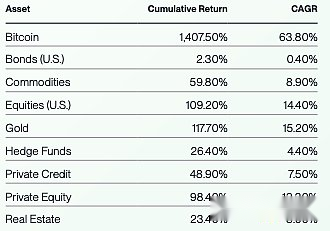
Source: Bitwise Asset Management, data from Bloomberg.The data dates are from January 1, 2020 to June 30, 2025.
The asset class is represented by the following, Bitcoin: Bitcoin spot price.Commodity: Deutsche Bank DBIQ Optimum Yield Diversified Commodity Index Total Return.Gold: spot price of gold.Hedge Funds: Bloomberg Macro Hedge Fund Index.Private Equity Credit: Indxx Private Equity Credit Index.Private Equity: S&P listed private equity total return index.Real Estate: MSCI US REIT Total Return Index.US Bonds: Bloomberg US Comprehensive Bond Index.US Stocks: S&P 500 Total Return Index.
1.4 Reserve assets, central bank purchases and a changing global order
Another important macroeconomic trend worth paying attention to in the next decade is the change in the role of the US dollar as the world’s dominant reserve currency.
Data shows that the dominance of the US dollar is weakening.This trend is reflected in the decline in the US dollar’s share in global central bank reserves, the decline in the US’ share in global GDP, and the recent purchases of alternative assets (mainly gold).
We are not arguing that the US dollar will inevitably lose its role as the world’s leading reserve currency.Instead, data suggests that its dominance is declining over time, creating room for a greater role in alternative assets and currencies.
We believe Bitcoin has a strong opportunity to gain a place in this feast of alternative assets over the next decade.More than a dozen countries, including the United States, now hold Bitcoin, and that number has increased over the past year.As Bitcoin is more functional in some ways than gold (easier to store, transport and verify), it may compete with gold over time, becoming one of the top hard assets held by central banks and governments.
As the world moves towards a more complex, multipolar future, we believe that multiple global reserve assets will emerge.We believe Bitcoin has a good chance of becoming one of these assets, and this view is reflected in our long-term price forecasts.
The share of US dollar in global foreign exchange reserves
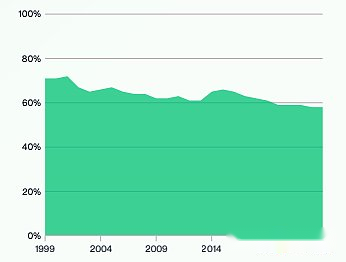
Source: Bitwise Asset Management, data from the International Monetary Fund (IMF).Data is as of December 2024.
The share of the US global GDP
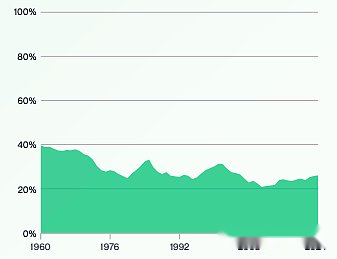
Source: Bitwise Asset Management, data from the World Bank.Data is as of December 31, 2024.
The central bank’s net gold purchase volume (tons)
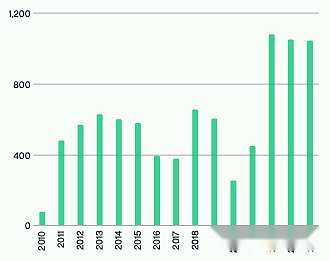 Source: Bitwise Asset Management, data from the World Gold Council.Data is as of December 31, 2024.
Source: Bitwise Asset Management, data from the World Gold Council.Data is as of December 31, 2024.
1.5 Regulatory assumptions
Over the past year, the global crypto regulation outlook has improved significantly.
The main catalyst is the 2024 U.S. election, which replaced an active opposition to crypto with a government that publicly supports crypto, reflected in changes in leadership of key institutions such as the Securities and Exchange Commission (SEC), the Office of the Comptroller of Currency (OCC), the Commodity Futures Trading Commission (CFTC), and the U.S. Treasury Department.
However, this trend is not limited to the United States.Active development is also being seen in several regions, including the Middle East, China, the UK and others, although at different paces.
The core question investors should ask about regulation is whether the recent positive tendency is a long-term secular trend or a brief partisan swing.That is, will the trend of supporting encryption continue regardless of the outcome of future elections?
We believe the answer is yes.
In the United States, crypto is one of the few policy issues that have received bipartisan support.Consider the GENIUS Act, which provides a regulatory framework for stablecoins, passed in the Senate by a 68-30 vote, with 18 Democrats voting for the bill.It was passed in the House with a similar big score advantage (308 votes to 122 votes).
It is worth considering the rarity of such bipartisan votes: The GENIUS Act is the only third bill to reach the critical 60-vote threshold during the 2025 Congressional session.
There are many reasons why encryption technology has gained bipartisan support, including its widespread popularity among young voters.But the most important explanation is that the U.S. financial industry — traditionally a major funder of the Democratic Party — supports the measure because it is eager to take advantage of the growth and profit opportunities offered by crypto.
This profit motivation is the core reason we believe crypto regulation will move in a positive direction: As a wider range of investors and companies get involved in crypto, it is increasingly difficult for politicians to unite against it.Today, almost every major financial institution in the United States has launched major crypto plans.If BlackRock, JPMorgan Chase and Morgan Stanley all invest heavily in crypto — plus thousands of American companies and millions of Americans — it’s hard to imagine politicians going to turn around.
The same is true globally, and many countries feel the need to compete in this emerging field.
Our view is that you can’t get the elves back into the bottle: encryption has entered the mainstream.That’s why we think the overall path to crypto regulation over the next decade will be positive.
Encryption adoption of institutions
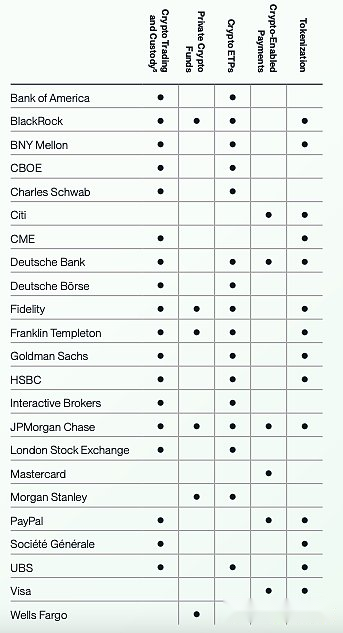
Source: Bitwise Asset Management, data comes from company documents and public statements.Data is as of June 30, 2025.
2. Bitcoin Capital Market Assumptions
2.1 Return assumption
We believe Bitcoin will become the world’s best performing major asset over the next decade, achieving a compound annual growth rate (CAGR) of 28.3%.
Our argument is driven by three main factors.
01 / Institutional Requirements
Bitcoin is rare in assets because retail investors lead its emergence.On the contrary, most emerging assets—private equity, private equity credit, etc.—are initially mainly accepted by institutional investors, and retail investors only develop interest in the later stages of the development of these assets.
Coupled with the strict scarcity of Bitcoin (which will always be only 21 million bitcoins), the retail-first nature of Bitcoin creates a unique situation: nearly 95% of almost all Bitcoins that will exist are already owned — mainly by retail investors — and most institutional investors have a allocation of 0%.
In recent years, various types of institutional investors have begun to allocate Bitcoin on an increasingly large scale.Since there are very few new bitcoins produced each year (about $18 billion at current prices), these investors have to buy bitcoins from existing investors.
The World Bank believes that institutional investors control about $100 trillion in total assets.Over the next decade, we believe these investors will allocate 1% to 5% of their portfolio to Bitcoin, meaning they will need to buy $1 trillion to $5 trillion in Bitcoin.
This has begun: Bitcoin ETP currently holds $170 billion in assets.But that’s just a small part of the down payment required for the total investment.
We believe this growing buying pressure will create sustained, long-term demand for Bitcoin, thereby pushing up prices.
02 / Limited supply
As mentioned above, the supply of Bitcoin is strictly limited: there will always be only 21 million Bitcoins.In addition, the vast majority of Bitcoins are already owned, and currently 19.9 million Bitcoins are in circulation (94.6%).
Bitcoin’s annual inflation rate is only 0.8%, and will drop to 0.4% in 2028 and 0.2% in 2032 (based on scheduled issuance plans, new issuances are halved every four years).In contrast, the annual inflation rate of gold supply fluctuates between 1% and 2%.
Importantly, the supply of Bitcoin is inelastic: no demand for Bitcoin or its price changes will lead to the production of more Bitcoin, unlike gold, oil, or other major commodities.
The colliding of huge institutional demand with limited, inelastic supply provides a simple economics-driven reason for our argument.
03 / Growing concerns about the depreciation of fiat currency
The growing institutional demand is backed by growing global concerns about debt, deficits and fiat depreciation, which has led to a scramble for alternative exposures to hedge fiat risks.
As legendary hedge fund investor Paul Tudor Jones wrote in a 2020 article titled The Great Monetary Inflation, which advocates buying a basket of hard assets: “The best profit maximization strategy is to have the fastest horse. If I were forced to predict, I bet it would be Bitcoin.”
U.S. federal debt has increased by $13.0 trillion over the past five years and is now at $36.2 trillion.The debt is now paying $952 billion in annual interest, making it the fourth largest spending item in the U.S. budget.Worse, interest rates now exceed expected GDP growth, making it more difficult to slow down debt growth in the future.
The combination of these three factors—institutional demand, limited supply, and growing concerns about the devaluation of fiat currencies—makes Bitcoin investors benefit as it wins a growing share of the store of value market, and the size of the market is also expanding.
Market Valuation Forecast
Models that predict the future value of Bitcoin are relatively new and are still evolving.The academic literature is limited and there is no consensus on the best approach.
Our preferred long-term valuation model is the Total Potential Market (TAM) model, which aims to estimate the future size of the markets that Bitcoin can serve and its expected future penetration in these markets.Given the fixed long-term supply of Bitcoin, this model allows us to estimate the future value of assets.
Bitwise Bitcoin Valuation Model
We believe Bitcoin has the ability to compete in multiple markets.This includes non-sovereign value storage markets like gold, as well as corporate treasury markets, national treasury reserve markets, etc.
The following table uses bear markets, baselines and bull market scenarios to provide context, highlighting the size of each market forecast in 2035 and our expectations for Bitcoin to penetrate the market at that time.
To be conservative, when calculating future prices at different penetration rates, we used 21 million long-term supply of Bitcoin, even if not all of these supplies will be in circulation in 2035 (and assume a considerable portion has been lost).
An important input to this model is our forecast for the size of each market category in 2035.In most cases, we draw this estimate by examining the historical growth rate of the assets in this category over the past decade and then extending that growth rate to the next 10 years.It is worth noting that even relatively slow growth rates will significantly recombinate within a decade.For example, we predict that the size of institutional investment assets will almost double, although its historical compound annual growth rate is relatively moderate, at 5.6%.
Readers may also notice that in our model, the store of value market has grown significantly, from $29 trillion to $92 trillion.This reflects the continued growth rate of the market over the next 10 years.We believe that this estimate may be conservative given that we expect more concerns about fiat depreciation over the next decade (and therefore increased interest in fiat hedging instruments).
We cannot find accurate historical estimates of the size of the offshore wealth market.Therefore, we applied a simple CAGR of 3.0% to this market.
For the purposes of our long-term capital market assumptions, we rely on the baseline scenario, which we believe is the most likely outcome.We include bear and bull market scenarios to reflect market uncertainty.
Bitwise’s Bitcoin Valuation Framework

Source: Bitwise Asset Management, data comes from Bloomberg, IMF, World Bank, BCG, APMEX, Carfang Group, EU Tax Observatory; Bitcoin price is as of June 30, 2025.The current market size has different deadlines, resulting in a different CAGR time period forecast for 2035.
The Bitcoin valuation framework and price targets are for illustration only and are not predictions of future results.This material represents an assessment of the market environment at a specific time and is not intended to predict future events or guarantee future results.
predict
Our baseline forecasts the value of each Bitcoin in 2035 to be $1.30674 million, equivalent to a CAGR of 28.3% from the current level.This is a significant decline from the previous 10-year and 5-year compound annual growth rates (82.5% and 63.8%, respectively), but remains high compared to Wall Street’s forecasts for traditional assets such as stocks, bonds, real estate and other assets.
We note that our forecasts are relatively close to estimates from other leading crypto analysts, including Alliance Bernstein (which predicts Bitcoin will exceed $1 million by 2033) and Standard Chartered (which predicts Bitcoin will exceed $500,000 by 2028).Our forecasts are more conservative than estimates from ARK Invest (to $1.5 million to $2.5 million by 2030) and Strategy (to $21 million by 2046).
Regarding other perspectives, we review other widely cited Bitcoin valuation models in the appendix.
Why is Bitcoin valuable?
One of the questions critics often ask about Bitcoin is: Why does it have any value?After all, Bitcoin does not generate cash flow.
We think the answer is simple.
We see Bitcoin as providing a service: the ability to store wealth in digital format without relying on banks or governments.The more people want this service, the more valuable Bitcoin is.The fewer people want this service, the lower the value of Bitcoin.If no one wants this service, the value of Bitcoin is zero.
This is no different from any other service.
The difference lies in how value is accumulated.For traditional software providers, users who want their services pay the company an annual subscription fee.For Bitcoin, you cannot pay the subscription fee.After all, there is no “bitcoin company”.Instead, the only way to get the service is to buy Bitcoin.If you buy Bitcoin, you get the service—the ability to store wealth in digital format without the need for a bank.
Nowadays, more and more people want Bitcoin services.That’s why it’s the best performing asset over the past decade.
We believe that more people will need this service in the future, as Bitcoin continues to mature and the demand for illegal currency assets grows.We are optimistic about the significance of Bitcoin’s future price.
2.2 Correlation assumptions
Bitcoin has extremely low long-term correlation with other major assets.Over the past 10 years, its average correlation with different asset classes is:
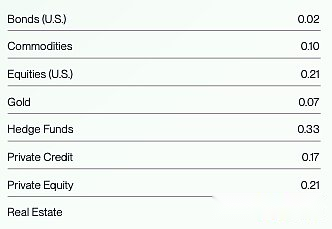
Source: Bitwise Asset Management, data from Bloomberg.The data dates are from June 30, 2015 to June 30, 2025.
The asset class is represented by the following.Bitcoin: Bitcoin spot price.Commodity: Deutsche Bank DBIQ Optimum Yield Diversified Commodity Index Total Return.Gold: spot price of gold.Hedge Funds: Bloomberg Macro Hedge Fund Index.Private Equity Credit: Indxx Private Equity Credit Index.Private Equity: S&P listed private equity total return index.Real Estate: MSCI US REIT Total Return Index.US Bonds: Bloomberg US Comprehensive Bond Index.US Stocks: S&P 500 Total Return Index.
Most observers believe that any correlation below 0.50 is a “low” correlation.
A careful study of the change of this correlation over time is very telling.The following chart shows its 90-day rolling correlation with U.S. stocks since the start of Bitcoin trading.It shows that Bitcoin’s correlation with U.S. stocks has almost never exceeded 0.50.In fact, despite being called a risky asset, its 90-day correlation with U.S. stocks has never reached a “high” level (i.e., over 0.75).
This fact is surprising, as media reports often describe Bitcoin as a “risk asset” with “highly relevant stocks.”Some even think it is a “Gabeta tech investment.”These perceptions stem from the fact that Bitcoin may be highly correlated with stocks during a brief and sharply negative decline, which is when the media tends to write stories about Bitcoin and relevance.
Consider the following: If you screen out those days when U.S. stock values fell 20% or more in the past 10 years, Bitcoin fell an average of 2.6% on those days.But it has also historically rebounded faster and further than the stock market, which is why the long-term correlation is low.
In terms of relevance, the gap between general perception and data-driven reality offers opportunities for portfolio builders.
Relevance to other assets
Since its inception, the correlation between Bitcoin and bonds has been approximately 0.00, as shown in the figure below.
This is both intuitive and powerful.Intuitively, Bitcoin’s drivers are different from bonds (see below for more).But it is powerful because it means that when Bitcoin is mixed with bonds in a portfolio, it provides a potential diversification tool.
Bitcoin also showed low correlation with a wide range of commodity, real estate, private equity and private credit indexes.
In other words, Bitcoin is maverick.
Bitcoin’s Relevance to U.S. Bonds (90 Days Rolling)
 Source: Bitwise Asset Management, data from Bloomberg, dated from July 19, 2010 to June 30, 2025.U.S. bonds are represented by the Bloomberg U.S. Comprehensive Bond Index.Note: The correlation between -0.5 and 0.5 is traditionally defined as a “low” or “no” correlation.
Source: Bitwise Asset Management, data from Bloomberg, dated from July 19, 2010 to June 30, 2025.U.S. bonds are represented by the Bloomberg U.S. Comprehensive Bond Index.Note: The correlation between -0.5 and 0.5 is traditionally defined as a “low” or “no” correlation.
Bitcoin and Commodity Relevance (90-day scrolling)

Source: Bitwise Asset Management, data from Bloomberg, dated from July 19, 2010 to June 30, 2025.Commodities are represented by Deutsche Bank DBIQ Optimum Yield Diversified Commodity Index Total Return.Note: The correlation between -0.5 and 0.5 is traditionally defined as a “low” or “no” correlation.
Bitcoin’s correlation with U.S. stocks (90-day rolling)

Source: Bitwise Asset Management, data from Bloomberg, dated from July 17, 2010 to June 30, 2025.U.S. stocks are represented by the S&P 500 Total Return Index Note: The correlation between -0.5 and 0.5 has traditionally been defined as a “low” or “no” correlation.
Bitcoin and Gold Relevance (90 Days Scroll)

Relevance of Bitcoin and Private Equity Credit (90-day rolling)

Source: Bitwise Asset Management, data from Bloomberg, dated from September 2, 2013 to June 30, 2025.Private equity credit is represented by the Indxx Private Equity Credit Index.
Note: The correlation between -0.5 and 0.5 is traditionally defined as a “low” or “no” correlation.
Relevance of Bitcoin to Private Equity (90-day rolling)

Source: Bitwise Asset Management, data from Bloomberg, dated from July 19, 2010 to June 30, 2025.Private equity is represented by the S&P listed private equity total return index.
Note: The correlation between -0.5 and 0.5 is traditionally defined as a “low” or “no” correlation.
Bitcoin’s Relevance to Real Estate (90 Days Rolling)

Source: Bitwise Asset Management, data from Bloomberg, dated from July 19, 2010 to June 30, 2025.Real estate is represented by the MSCI US REIT Total Return Index.Note: The correlation between -0.5 and 0.5 is traditionally defined as a “low” or “no” correlation.
Drivers of low correlation between Bitcoin and other assets
We believe that Bitcoin has a low long-term correlation with stocks and bonds for two reasons.
01 / One-time secular trends
First of all, Bitcoin is undergoing a one-time maturity process, transforming from a small ecological niche asset that many people are unfamiliar with and unproven to a widely held alternative asset.This shift involves millions of investors investing in Bitcoin for the first time, providing an asymmetric skew inflow, unlike the two-way flows that affect most other mature assets.This effect may weaken over time, but it is an important driver of Bitcoin’s unique return characteristics.
02 / Different drivers
Bitcoin’s drivers are different from stocks, bonds and other assets.While stocks and bonds are driven by economic growth, tax rates, geopolitical developments and technological advances, Bitcoin is driven by factors such as adoption rates, regulatory progress, and concerns about devaluation of fiat currencies.While there is overlap – all assets are affected by monetary and fiscal factors, for example – you usually expect Bitcoin returns to be different from stocks and bonds given the differences in their performance drivers.
We believe both factors will continue in the future.Therefore, we expect Bitcoin’s correlation with stocks and bonds will generally remain within the low range of 0.00 to 0.50 over the next decade.
We have noticed that Bitcoin is more correlated with stocks in the post-COVID era, and we attribute it to the growing impact of monetary and fiscal policies on stocks and bonds.Since we expect this trend to continue to some extent, we use a hierarchical weighting method to raise the weight of the impact of recent correlation trends in correlation predictions.Using this method, we expect the average correlation between Bitcoin and U.S. stocks to be 0.39 over the next 10 years.
Using the same approach, we expect a correlation with commodities of 0.07, gold as 0.07, hedge funds as 0.32, private credit as 0.27, private equity as 0.36, real estate as 0.27, and U.S. bonds as 0.00.
2.3 Volatility assumptions
Bitcoin’s volatility has been declining over the past decade – so has its volatility.In the figure below, this is illustrated by the trajectory of volatility and its tighter band-like distribution over time.
Bitcoin’s historical volatility
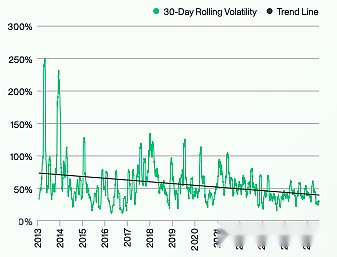
Source: Bitwise Asset Management.The data dates are from January 1, 2013 to June 30, 2025.
We believe these trends reflect the fundamental reduction in risk for Bitcoin as an investment over the past 10 years, as well as the diversification of its investor base.We expect both trends to continue over the next decade, so Bitcoin’s volatility (and its second-order volatility) will continue to decline as well.
However, our model assumes that Bitcoin volatility will decline by 50% slower than historical trends.This reflects our view that some of the most fundamental challenges facing Bitcoin have significantly reduced risks, including risks related to regulation, adoption, custody, liquidity, and more.As the risks that need to be eliminated in the market decrease, it is reasonable to expect a slowdown in Bitcoin volatility to decline.
A historical analogy: gold
Investors questioning the long-term downward trend of Bitcoin volatility can use gold as a useful historical analogy.
Investors think gold is an asset that has been around for thousands of years, but in reality, in modern times, it only has about 50 years of floating prices.For most of the United States’ existence, the dollar value of gold was usually fixed, and politicians did not officially break the gold-dollar ties until 1971.
The chart of gold price trends after this break is very inspiring.Initially, gold’s volatility soared to unusually high levels as investors struggled to determine their role after the gold was decoupled from the dollar.As investors gradually accepted their new position in the world, their volatility generally declined in the following 26 years and bottomed out in 1997.
Historical volatility of gold
Source: Bitwise Asset Management, data from Bloomberg.The data dates are from January 2, 1975 to June 30, 2025.
Importantly, gold’s volatility did not drop to zero; in fact, it rebounded in the late 1990s and soared significantly during the 2008 financial crisis.These surges reflect changes in the fundamentals of the gold market.Today, it is usually slightly less volatile than U.S. stocks and slightly more than U.S. bonds.
We expect similar long-term results for Bitcoin.It is currently in the stage of establishing its world status, which is driving a one-time decline in its volatility.Ultimately, we expect it to reach a steady state with average volatility similar to gold.
For modeling purposes, we position Bitcoin’s future volatility at the midpoint of its expected journey from 2025 to 2035.This sets it at 32.85%.In fact, we expect the volatility in the near future to surpass the volatility of Bitcoin when the market is more mature in the coming years.
2.4 Periodic Assumption
Bitcoin has historically operated in a four-year cycle, with three significant “ups” years followed by a sharp pullback year.If the four-year cycle is repeated, 2026 will be a year of pullback.
Bitcoin’s performance: four-year cycle

Source: Bitwise Asset Management.The data dates are from December 31, 2010 to June 30, 2025.
Note: The name given to the four-year cycle represents our assessment of the power that contributes the most to Bitcoin performance during this period.Performance information is only used to provide information.The return reflects the return of Bitcoin itself, not the return of any fund or account, and does not include any fees.Back-retrospective performance cannot predict the future performance of any investment strategy.The future encryption cycle may not be four years; the four-year increment is based on historical data and is used for illustration purposes, not a prediction of future results.This material represents an assessment of the market environment at a specific time and is not intended to predict future events or guarantee future results.
There is no consensus on what drives this significant pattern.Let’s discuss four main theories below.
01 / Bitcoin Half
Every four years, the number of newly produced bitcoins is reduced by half.Although the date of the halving does not exactly match the beginning or end of the Bitcoin price cycle, many attribute the cycle to the long-term effects of this reduction in supply.
02 / Interest rate cycle
The previous year of decline (2018, 2022) coincided with a period of rapid rate hikes by the Federal Reserve.Many believe that these interest rate shocks have contributed to a sharp correction in Bitcoin.
03 / Crypto Credit Cycle
Some researchers attribute the four-year cycle to the classic boom and bust economic cycle: novel innovations generate new investments and strong returns, which in turn attract leverage and bad actors until prices reset.In the case of Bitcoin, each callback is accompanied by a crash, the 2014 Mt. Gox crash, the 2018 SEC blow to fraudulent ICOs, and the 2022 FTX crash.
04 / Contingency
Some observers think the four-year cycle is accidental, noting that it only happened three times.
At Bitwise, we suspect that all four arguments contain partial truth.In any case, we believe that the four-year cycle is unlikely to repeat in the future, for the following reasons.
First, no matter which explanation you look at, the effects of these forces (except for accidentality) have diminished.For example, each subsequent Bitcoin halving reduces the supply by half of the previous one, resulting in a decrease in impact.Interest rates are unlikely to rise significantly in the near future; instead, most experts call for a rate cut.Likewise, leverage in encryption systems is relatively controlled (for now – this is worthy of attention), so the boom-bust cycle effect may be weaker than historical periods.We also need to add that improved regulation reduces the possibility of a crash that occurred during the 2014, 2018 and 2022 pullbacks.
Second, we believe that the wave of institutional capital entering the field (which officially began with the approval of the 2024 spot Bitcoin ETP) will last for many years, partly because there is still a large portion of the institutional market that is still untapped.This will provide sustained upward pressure on Bitcoin prices, which is inconsistent with the historical four-year cycle.
Third, we believe that with the 2024 election that supports encryption, the regulatory shift also created a multi-year tailwind that spans the four-year cycle of history.
We still expect market volatility and a significant retracement in Bitcoin prices.But we do not expect the classic four-year cycle to continue to hold in the future.
3. Bitcoin vs. Traditional assets
Long-term capital market assumptions are useful for investors because they help design effective portfolios.Therefore, it is important to consider not only the long-term prospects of Bitcoin, but also the relative prospects of other asset classes.
To do this with non-crypto assets, we take a simple average of the latest long-term capital market assumptions for four leading financial institutions—JP Morgan, PIMCO, BlackRock and Vanguard—.
It is worth noting that each provider uses different time periods (between 5 and 10 years) for assumptions, and they use different target indices to model asset class returns.For the purpose of creating average predictions, we ignore these differences.Therefore, the following table should be considered as an approximate mean, rather than an accurate population prediction.
Not surprisingly, the results show that Bitcoin is both the best performing and most volatile major asset, and is less relevant to other assets.This is consistent with its historical performance and the possible outcomes we predict.
2025-2035 Forecast: Bitcoin’s Returns, Volatility, and Relevance to Major Asset Classes

Source: Bitwise Asset Management.Bitcoin’s return and volatility forecasts are formulated by Bitwise.Forecasts for other asset classes are the average of estimates reported in JPMorgan, PIMCO, BlackRock and Vanguard Capital Markets, which may be based on different indices and date ranges.
For relevance, asset classes are represented by the following.Bitcoin: Bitcoin spot price.Commodity: Deutsche Bank DBIQ Optimum Yield Diversified Commodity Index Total Return.Gold: spot price of gold.Hedge Funds: Bloomberg Macro Hedge Fund Index.Private Equity Credit: Indxx Private Equity Credit Index.Private Equity: S&P listed private equity total return index.Real Estate: MSCI US REIT Total Return Index.US Bonds: Bloomberg US Comprehensive Bond Index.US Stocks: S&P 500 Total Return Index.
Note: The correlation between -0.5 and 0.5 is traditionally defined as a “low” or “no” correlation.
4. Risk and considerations
Bitcoin is an asset with high volatility and limited history.Regulations around Bitcoin are developing rapidly, and institutional adoption is still in its early stages, and the underlying technologies that support Bitcoin are relatively new.Furthermore, these and other factors make the process of predicting future returns, correlations and volatility of Bitcoin itself uncertain and face significant risks and potential errors.
Here are one of the key risks to consider.
01 / Bitcoin Limited History
Bitcoin was developed in 2008-09 and began trading widely on public exchanges in 2010.The first institutional investment product to offer Bitcoin exposure was launched in 2014, while the spot ETP, which is pegged to Bitcoin, was not launched until 2024.
The result of these relatively short time periods is that there is limited data available for evaluation when predicting Bitcoin’s future returns, correlations, and volatility.Given the changing nature of the Bitcoin market, regulation and other developments, future returns may not be very similar to those in the past, which poses additional risks.Analysts studying Bitcoin’s historical returns can only examine returns under macroeconomic conditions that exist since its launch, and future macroeconomic conditions may differ from those in the past.
Because Bitcoin’s history is limited, investors should carefully consider Bitcoin predictions that rely heavily on historical data.Although we have tried to consider these risks in our analysis, these risks remain.
02 / Regulatory and legislative risks
The regulatory and legislative environment around Bitcoin is newer and less developed than many other assets and is changing rapidly, both in the United States and abroad.Major unexpected changes in Bitcoin’s regulatory and legislative status in the United States or around the world may significantly change the prospects of Bitcoin, both positive and negative.
03 / The adoption of Bitcoin by institutions, companies and governments is a new trend
Bitcoin was originally a primarily retail-led asset.In recent years, institutions, companies and governments have begun to acquire Bitcoin, and its future growth prospects are largely dependent on the continued adoption of these investor groups.However, this is a relatively new development and it is uncertain whether the recent adoption trend will continue into the future.
04 / Technology and Quantum Risk
Bitcoin is a technology, and any technology comes with risks.In order for the Bitcoin blockchain to run well, its underlying source code must be constantly updated as the surrounding technical environment changes.There is a risk that Bitcoin cannot keep up with the pace of the times, and if it cannot do this, it will face technological or competitive challenges.
For example, if quantum computing (technology designed to process exponentially higher rates than today’s supercomputers) evolves rapidly, the core technologies behind Bitcoin and many Bitcoin wallets could be at risk.At some point in the future, the Bitcoin blockchain may have to undergo a major upgrade to move towards quantum cryptography to mitigate risks in the field.Even if Bitcoin successfully completes this upgrade – which is uncertain – they can also be at risk if personal wallets do not transfer assets to quantum-resistant addresses.Failure to fully adapt to the advancement of quantum computing could put Bitcoin blockchain and Bitcoin investment at risk.
05 / Other risks
Bitcoin also poses many other significant risks, including risks associated with macroeconomic developments, transactions, custody and other factors.This document is not an attempt to define all the risks associated with Bitcoin, but emphasizes specific risks that may bring uncertainty to our capital market assumptions.
V. Conclusion
In its short 16-year history, Bitcoin has transformed from a lesser-known marginal investment into a $2.4 trillion asset, held and studied by some of the world’s most mature investors.This journey is marked by excellent returns, unusual volatility, and important new questions about its future risk-reward characteristics.As institutional investors increasingly weigh the unique characteristics of the asset, it becomes more critical to obtain high-quality data and forecasts when simulating Bitcoin’s role in their portfolios.
This report provides this basis.
Our analysis has led us to derive the following key capital market assumptions for Bitcoin over the next decade:
01. Institutional investors will allocate 1% to 5% of their portfolio to Bitcoin, that is, $1 trillion to $5 trillion.
02. Growing government debt, public spending and monetary expansion will put downward pressure on fiat currencies, which will increase demand for store-of-value assets such as gold and Bitcoin.
03. Given the increasing acceptance of Bitcoin by Wall Street and mainstream society, recent regulatory progress is unlikely to be reversed in the future political environment.
04. We believe that the four-year cycle in Bitcoin’s history is no longer applicable because of the weakening of the impact of halving, the depth of new institutional demand, and enduring regulatory progress.
Putting all this together, over the next decade, we predict Bitcoin’s compound annual growth rate will be 28.3%, with volatility of 32.9%, and will continue to remain low in correlation with stocks, bonds, commodities and other traditional assets.In this case, the next 10 years will represent the institutional era of Bitcoin, in which it becomes a mainstream alternative asset that any thoughtful investor can hardly ignore.
Appendix: What other models think about the future price of Bitcoin?
While we strongly tend toward the TAM (total potential market) model, the crypto industry broadly follows a variety of other Bitcoin valuation models.We do not agree with these models.However, given their widespread attention – and that no model is perfect in reality – it is worth considering the three most frequently cited models’ views on the potential appreciation space of Bitcoin.
Model 1: Stock-to-Flow Model
The Bitcoin Stock-Traffic Model was originally proposed by a pseudonym crypto research analyst PlanB in 2019 in an article titled Modeling Bitcoin Value with Scarcity.The stock-traffic model assumes that the value of Bitcoin is related to its scarcity.Specifically, it considers that there is a logarithmic relationship between the market value of Bitcoin and the ratio of its total circulating supply (“stock”) and its annual new supply (“flow”).The model is closely related to the idea that Bitcoin’s “halving” process every four years—that is, the halving of the number of newly produced bitcoins each year—is a key driver of the asset’s value.
PlanB updated the model in April 2020, introducing the “stock-traffic cross-asset model”, which tests multiple assets on a relationship basis.
Critics of the stock-traffic model point to its inherent bullish bias: Because the stock-traffic ratio of Bitcoin increases programmatically over time, the model predicts that Bitcoin will continue to rise forever.Others pointed out that it did not consider macroeconomic or regulatory developments.
Stock-traffic model predicts that the price of Bitcoin will be US$1.16 million in 2035.
Model 2: The Bitcoin Power Law Model
The Bitcoin power law model was proposed in 2022 by an crypto researcher named Dilution-proof and has gained attention as an alternative to the stock-traffic model.
The Bitcoin power law model is based on the observation that Bitcoin’s price historically follows the power law relationship.The model predicts that the price of Bitcoin will fluctuate between support and resistance levels, which can be estimated by connecting previous highs (and lows) on the logarithmic chart of Bitcoin price to time.
The Bitcoin power law model is a descriptive model, not a causal model.Like the stock-flow model, it is also bullish by definition, predicting that Bitcoin will continue its upward trajectory over time.
The Bitcoin power law model is expected to be $1.5 million in 2035.
Model 3: The Bitcoin Autocorrelation Exchange Rate Model
The Bitcoin Autocorrelation Exchange Rate Model (BAERM) is a quantitative model designed to explain and predict the price of Bitcoin based on the premise that Bitcoin returns are autocorrelated—that is, its price moves according to a self-referential historical pattern.The model assumes that Bitcoin price expands exponentially over time, but this trend is affected by the halving era, market effects, and the daily autocorrelation of Bitcoin prices.
The model is complex.It attempts to provide a more comprehensive analysis of Bitcoin’s historical price trends than standard trend tracking or momentum models, while still trying to explain the true impact of momentum in the Bitcoin space.
The model is retrospective and does not include factors such as demand, macroeconomic conditions or regulatory developments.Skeptics believe it over-indexes historical returns and that the off-sample results of this recently introduced model will be less predictive than historical results.Since the model was only recently introduced (2023-24), it is still too early to judge.
The Bitcoin autocorrelation exchange rate model predicts that the price of Bitcoin will be US$7.5 million in 2035.

